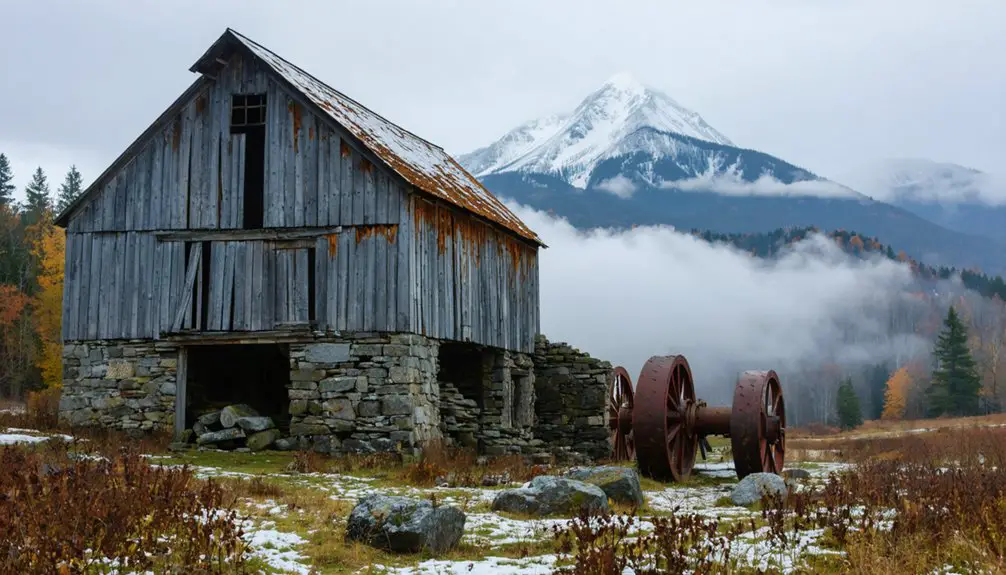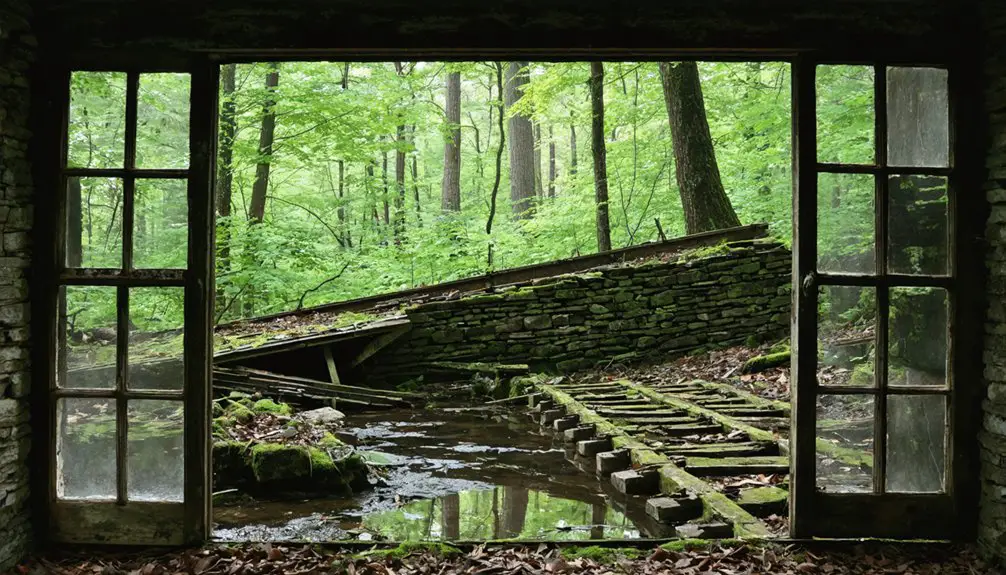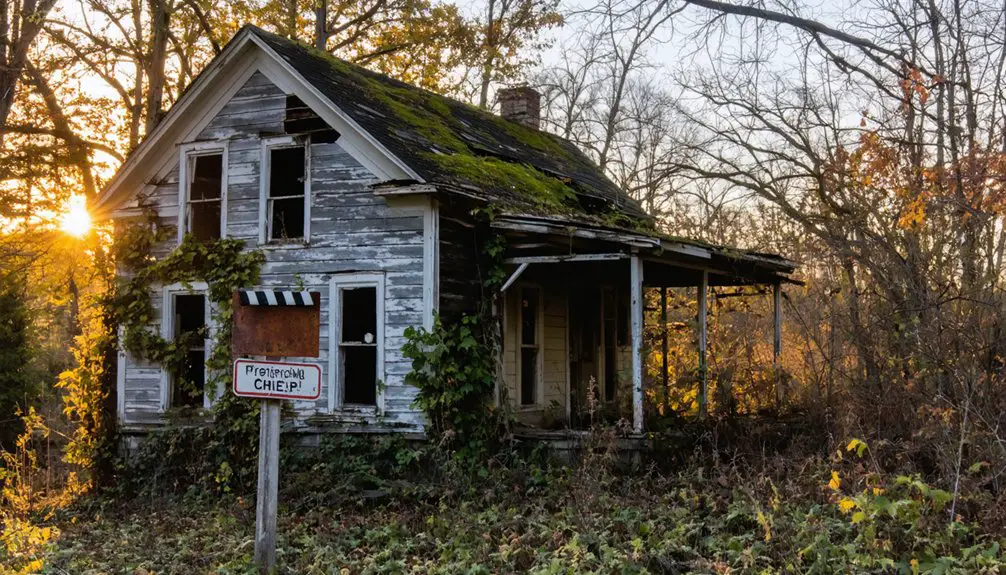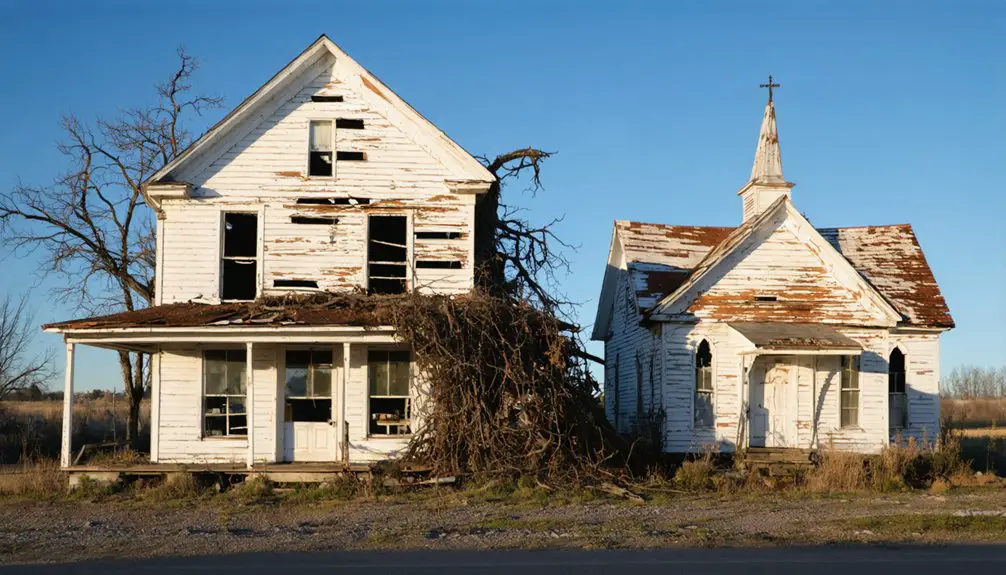You’ll find East Elmore’s remnants nestled in Vermont’s mountain valleys, where brothers Martin and Jesse Elmore first settled in 1790. Their bustling sawmill community thrived through the 1800s until timber resources declined. By 1936, the state acquired 755 acres, and the CCC transformed the industrial sites into Elmore State Park. Today, only stone foundations remain amid marshy terrain, while the historic 1939 fire tower stands as a silent sentinel to the area’s rich past.
Key Takeaways
- East Elmore’s sawmill-based economy collapsed in the early 20th century, leading to population decline and eventual abandonment.
- Only stone foundations remain of East Elmore’s original structures, surrounded by marshy terrain and wilderness.
- The state’s acquisition of 755 acres in 1936 transformed the former settlement into parkland, marking its transition to abandonment.
- The community’s isolation and harsh winters contributed to its decline, making sustainable living increasingly difficult for residents.
- The area was converted into recreational space by the Civilian Conservation Corps, preserving its natural features rather than rebuilding settlements.
Early Settlement and the Elmore Brothers

While several Vermont settlements were already established by 1790, the arrival of Martin and Jesse Elmore marked the beginning of East Elmore’s permanent colonization. The brothers, sons of Revolutionary War Colonel Samuel Elmore, journeyed by boat alongside fellow pioneers James and Seth Olmstead and Aaron Keeler to this mountainous region.
The Elmore legacy quickly took root as the family established homesteads and farmsteads in the area. Their pioneer collaboration with other settlers proved essential for survival and development in this isolated terrain. Similar to the Equivalent Lands transfer of 1716, early Vermont land distribution played a crucial role in establishing permanent settlements. The area became known for its saw milling operations, which the early settlers established to harness the region’s natural resources.
As sons of a distinguished military leader, the Elmores’ influence extended beyond mere settlement – their family name became permanently embedded in the town’s identity, and their presence shaped the social and political foundations of this nascent community throughout the late 18th and early 19th centuries.
Life in the Mountain Valley
You’ll find that daily life in East Elmore’s mountain valley revolved around the demanding cycles of agriculture, with farmers rising before dawn to tend livestock and work their hardwood-cleared fields.
The village’s isolation among the Worcester Mountains meant residents had to be largely self-sufficient, maintaining food cellars and preserving harvests to survive the harsh Vermont winters. The region’s good quality soil supported prosperous farming operations despite the challenging landscape.
Through spring planting, summer haying, and fall harvesting, families worked alongside their neighbors, sharing labor and equipment while adapting their routines to the steep terrain and short growing season. The Civilian Conservation Corps later helped establish crucial infrastructure in the area during the Great Depression.
Daily Agricultural Routines
Despite the challenging mountain terrain, East Elmore’s farmers developed efficient agricultural routines that maximized their valley’s limited resources.
Similar to King Farm’s beef cattle operations today, you’d start your day before dawn, first tending to livestock management tasks – milking cows, feeding animals, and cleaning their shelters. Throughout the growing season, you’d work the fields using crop rotation between corn and hay to maintain soil health, supplementing with manure from your cattle and sheep.
Your daily schedule would align with the water-powered mills’ operations, coordinating lumber processing and grain grinding with your fieldwork. You’d maintain your domestic garden, preserve food in the ice house, and repair tools.
During peak seasons, you’d join with neighboring families to tackle demanding tasks like shearing sheep, harvesting crops, and producing maple sugar.
Mountain Isolation Effects
Living in East Elmore’s mountain valley brought unique challenges that shaped every aspect of daily existence.
You’d find yourself battling physical isolation during harsh winters when landslides and snowstorms blocked the few available roads, cutting off your escape routes and access to essential supplies.
The mountain isolation didn’t just affect your ability to travel – it took a toll on your mental well-being too.
With limited access to healthcare providers and scarce mental health resources, you’d face significant barriers to maintaining both physical and emotional wellness.
Community health suffered as the sparse population and geographical barriers made it difficult to maintain strong social connections. The lack of structural resources like transportation and broadband internet worsened the isolation of mountain residents.
You couldn’t simply walk to a neighbor’s house for support, and poor internet connectivity meant even virtual socializing remained out of reach.
Seasonal Work Patterns
While farming remained the backbone of East Elmore’s economy, your work life would shift dramatically with each passing season.
You’d start in late winter tapping maple trees for syrup production, then change to spring planting as the ground thawed.
Summer brought intense agricultural cycles of tending crops and maintaining fields, while also catering to tourists visiting Elmore State Park.
Fall meant all hands on deck for harvest, followed by Christmas tree cutting and selective logging operations before heavy snows arrived. The area’s annual 36-40 inches of rainfall created unique challenges for timing harvests and field work.
Seasonal employment peaked during the warmer months when farms needed extra workers, and tourism created additional jobs.
During winter’s quiet months, you’d focus on equipment maintenance, forest management, and preparing for the next year’s activities, adapting to the mountain valley’s natural rhythms.
From Sawmills to Wilderness
As the densely forested slopes of East Elmore first beckoned settlers in 1790, the abundant water power from mountain tributaries and Elmore Lake proved ideal for establishing sawmills.
Like many ghost town remnants, East Elmore’s structures stand as a testament to America’s industrialization period.
This sawmill heritage defined the community’s early years, with timber processing driving the local economy through the 19th century.
You’ll find that East Elmore’s evolution began as timber resources dwindled and markets became harder to reach.
By the early 20th century, the once-bustling sawmills fell silent.
The area was transformed in 1936 when the state acquired 755 acres for parkland development.
The 1930s marked the wilderness change, as the CCC launched conservation projects and rebuilt the forest after the 1938 hurricane.
They added a fire lookout tower on Elmore Mountain and gradually converted industrial sites into what’s now Elmore State Park, trading lumber production for recreational spaces you can explore today.
The CCC’s Transformation

The Civilian Conservation Corps (CCC) entered East Elmore in 1934 after the U.S. government purchased land from the McKee, Stafford, and Barrette families. When they arrived, they found only an old hotel on Elmore Mountain’s eastern slope.
The CCC’s impact quickly transformed the rugged landscape into an accessible recreational area. You can still see their legacy today in the distinctive architecture of the bath house and the original gravel road they carved from Vermont Route 12.
They built nearly twenty structures and reshaped the wilderness into grassy, wooded recreational spaces. While most CCC buildings were removed after Vermont’s 1938 takeover, their recreational development permanently altered East Elmore’s character.
The project provided jobs and training during the Depression until 1942, when World War II drew workers away.
Fire Tower Legacy
If you’d visited East Elmore in 1939, you would’ve seen the newly constructed 46-foot steel fire tower standing watch from its mountaintop perch.
For the next 35 years, dedicated lookouts climbed the tower daily during fire season to protect Vermont’s forests through visual surveillance of the surrounding landscape. The lookouts earned two dollars per day for their vital work monitoring for signs of smoke and forest fires.
The tower remained active until 1974, when advances in aerial detection made traditional fire towers obsolete, though it continues to stand today as a tribute to Vermont’s forest protection legacy.
Mountaintop Guardian Stands Watch
Standing sentinel atop Elmore Mountain since 1939, Vermont’s first state-erected fire tower emerged from post-hurricane recovery efforts as a critical forest protection asset.
The tower’s design featured a 46-foot steel skeleton structure, replacing vulnerable wooden predecessors and showcasing the state’s commitment to durable fire observation infrastructure.
You’ll find the tower perched on a 14-foot square concrete base, tapering gracefully to a 7-foot platform that once housed dedicated lookouts who earned $2 per day scanning the horizon for smoke.
While the observer’s cabin has vanished and the viewing equipment was removed in 1974, the tower’s structural integrity remains remarkably intact.
Today, as part of Elmore State Park, this National Historic Lookout continues to draw hikers and history enthusiasts to its preserved steel frame.
Decades of Fire Prevention
Emerging from Vermont’s early conservation movement, fire towers revolutionized forest protection across the state beginning in the 1900s.
You’ll find that Burke Mountain hosted Vermont’s first tower, funded by wealthy landowner Elmer Darling to safeguard his timberland.
The CCC’s expansion efforts in the 1930s and ’40s brought steel towers like Elmore’s, which stood 46 feet tall on a concrete base.
These durable structures replaced wooden designs that couldn’t withstand severe weather.
Fire prevention efforts intensified after the devastating 1938 New England hurricane, with lookouts earning $2 daily to scan for smoke signals.
While modern aerial patrols made many towers obsolete by the 1980s, Elmore’s tower earned National Historic Lookout status in 1995, preserving its legacy in forest conservation history.
Tower’s Final Active Years
Though modern aerial surveillance would eventually replace fire towers across Vermont, the Elmore tower served as an active fire detection station from 1939 until 1974.
During its final years, lookouts earned just $2 per day to scan the surrounding forests for signs of smoke and fire. You’ll find it remarkable that these dedicated workers operated from a 46-foot steel structure with a 7-foot platform, maintaining vigilant watch over the landscape.
The tower, designated as US #140 and VT #03, represented the culmination of Vermont’s fire prevention efforts that began in the early 1900s.
As aerial patrols became more prevalent in the late 1960s, lookout duties gradually diminished until the tower’s decommissioning in 1974, marking the end of an era in forest protection.
Lost Structures and Remnants
When you visit East Elmore today, you’ll find only stone foundations scattered amid marshy terrain where buildings once stood. Unlike other Vermont ghost towns that retain some structures, East Elmore’s buildings were deliberately burned and destroyed, leaving minimal archaeological significance beyond their stone footprints.
While nearby Medburyville disappeared beneath Harriman Reservoir, East Elmore’s remnants tell a different story of structural decay. You can still trace the community’s layout through foundation stones, though dense vegetation and marshland make exploration challenging.
The Cold War-era Air Force buildings on East Mountain, abandoned since 1963, offer the area’s only standing structures – though they’re unsafe and asbestos-laden. These deteriorating military facilities provide a stark contrast to East Elmore’s vanished mills, houses, and agricultural buildings that once formed this rural community.
Natural Preservation Efforts

Since 1934, natural preservation efforts in East Elmore have centered on the groundbreaking work of the Civilian Conservation Corps (CCC).
You’ll find their legacy in the thoughtful conversion of wilderness areas around Elmore Lake, where they built recreational facilities while preserving the natural landscape.
Today’s natural conservation continues through strategic zoning policies. The Rural-East District and Remote Area Overlay protect ecological integrity by limiting development and preventing habitat fragmentation.
Smart zoning designations in East Elmore guide sustainable growth while protecting vital ecosystems and wildlife corridors from urban sprawl.
You’ll notice strict regulations in the Forest Reserve District, which safeguards high-elevation features and wildlife corridors.
The Vermont Department of Forests, Parks and Recreation maintains the CCC’s vision, balancing public access with preservation.
Local initiatives, including the Elmore Community Trust, reinforce these efforts through historic property preservation and enforcement of conservation-minded bylaws.
Modern Rural Character
The rural character of modern East Elmore emerges directly from its preserved natural landscape.
You’ll find a delicate balance between wilderness and managed recreational spaces, where the CCC’s 1930s infrastructure projects enhanced accessibility while maintaining the area’s remote charm. The mountainous terrain continues to shield East Elmore from urban encroachment, preserving its cultural heritage through limited development and steady, low population density.
Today’s community resilience is evident in how East Elmore adapts to modern needs while retaining its historic identity.
The presence of Elmore State Park brings seasonal visitors who support the local economy without disrupting the area’s quiet nature.
You’ll discover a place where historic family names still echo through the landscape, even as traditional industries have given way to conservation and outdoor recreation.
Frequently Asked Questions
What Happened to the Original Elmore Family Members After Settling East Elmore?
You’ll find that Elmore descendants maintained farming and forestry operations through the 19th century, though their family legacies gradually shifted as later generations sold land or adapted to changing economic conditions.
Were There Any Notable Conflicts Between Early Settlers and Native Americans?
Like texting gone wrong, settler interactions with Western Abenaki turned hostile during Dummer’s War (1722-1725), with native disputes involving raids, burning villages, and battles until most indigenous people retreated northward by 1749.
What Was the Average Property Value in East Elmore During Peak Settlement?
You can’t determine the average property values during peak settlement, as historical records don’t preserve specific transaction prices or assessments from East Elmore’s early development period.
Did Any Famous Historical Figures Ever Visit or Stay in East Elmore?
Despite reviewing over 200 years of historical records, you won’t find any famous historical visits or notable guests documented in East Elmore’s archives, apart from Colonel Samuel Elmore himself.
Were There Any Documented Paranormal Activities in Abandoned East Elmore Structures?
You won’t find documented paranormal sightings or ghost stories specific to abandoned structures in this location. While Vermont has many haunted spots, there’s no verified supernatural activity from these particular ruins.
References
- https://www.geotab.com/ghost-towns/
- https://www.uvm.edu/histpres/HPJ/NR/elmore/nrstat.html
- https://www.uvm.edu/histpres/HPJ/NR/elmore/nrdes.html
- https://elmorevt.org/wp-content/uploads/East-Elmore.html
- https://en.wikipedia.org/wiki/Elmore
- https://sites.rootsweb.com/~vtwindha/hev/hevch5.htm
- https://elmorevt.org/wp-content/uploads/About.html
- http://larrycoffin.blogspot.com/2013/
- https://vermont.com/cities/elmore/
- https://outside.vermont.gov/agency/ACCD/bylaws/Bylaws and Plans Approved/Elmore_Adopted_MunicipalPlan_August_2008.PDF



